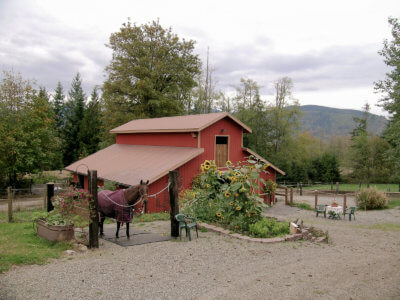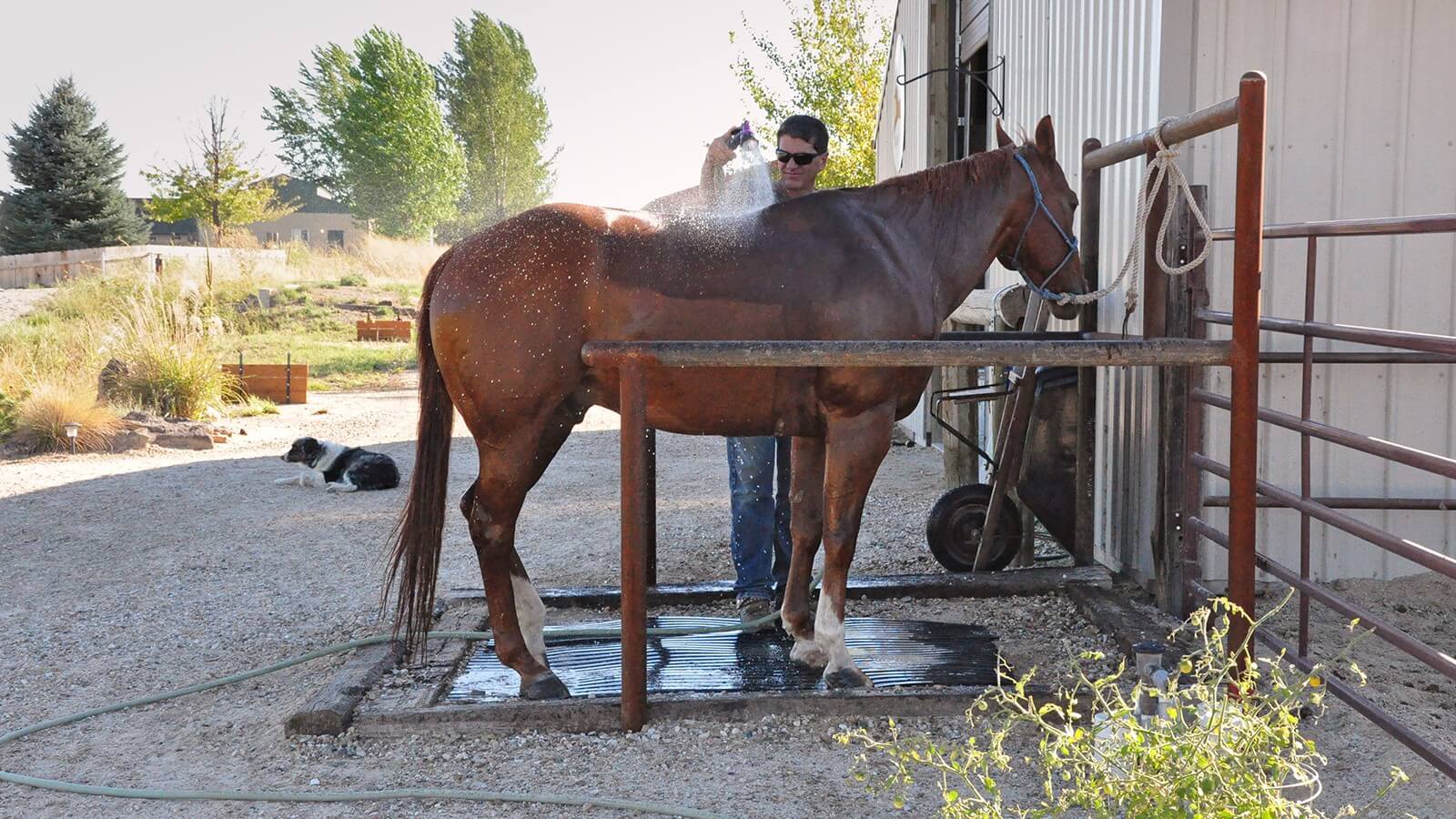Outdoor wash racks are a 3-season way to hose off or bathe your horse while allowing the water to recharge the natural hydrology of your property. Even if you already have an indoor wash stall, during the warm summer months an outdoor wash rack can provide extra bathing capacity for a facility and keep things from getting backed up. If you don’t already have a place to bathe your horse, outdoor wash racks can be low cost and low maintenance to build. Plus, it is just plain nice to be outside!
Here are a few key points to keep in mind for setting up your outdoor wash rack.
Soil type: Outdoor wash racks require well-drained soils in order for them not to turn into a quagmire. Repeated use of your wash rack will quickly turn wet or organic soils into mud.
Location: Choose a higher area (versus a low spot which will collect water and turn into a bathtub). Stay away from creeks, ditches, wetlands, or other water bodies as well as away from manure storage areas (so that water runoff does not pollute waterways or collect in manure storage).
Chore efficiency: Your wash rack should be convenient to your barn or shelter area, as well as close to a faucet/water source.
Size: A wash rack can vary in size — from slightly larger than the footprint of a horse (approximately 10 feet x 4 feet) to a generous box stall size (16 feet x 16 feet) — or larger if you plan for bathing multiple horses at once.
Footing: Crushed rock footing (no larger than 5/8 inch for the comfort of the horse) 3 to 6 inches deep improves drainage. Washed or clear rock will drain best. Angular crushed will lock in place which round rock will not do. Stall mats can be placed on top of crushed rock. You may wish to frame in the wash rack footing to hold the material and mats in place. Tip: for cost savings, consider recycled conveyor belting instead of stall mats.
Side rails: Having side rails defines a space, holds the horse in, and keeps a horse from moving away from the spray of the hose. However, side rails can be confining and potentially dangerous if a horse panics, pulls back and traps you so design the space with handler safety in mind.
Ties: Cross ties can help to keep a horse from thinking they can turn around in the wash rack. Some sort of tie system is necessary to keep a horse from moving about. Remember to always tie a horse high and short on a sturdy post, not a rail.
Hose: The hose can be as simple as a hose you drag around (make sure your horse is desensitized to hoses before you put them in the wash rack and commence bath time). Or the hose could be affixed to an overhead boom which make bathing easier.
Material choices: Side rails and posts can be made from any strong, sturdy, waterproof material such as railroad ties or welded pipe. Be sure corners are safe and there are no protruding objects where a horse could get hurt like bolt ends, nails, boards or the tops of metal posts. Watch out for sharp corners or rough bottom edges.
 Vegetated filter strip buffer: (use photo vegetation.jpg if possible. Surround an outdoor wash rack with vegetation. Healthy soil and plants break down contaminants such as from soaps or fly sprays and help prevent runoff and mud. This can be as simple as lawn grass or as sophisticated as a pollinator hedgerow or rain garden.
Vegetated filter strip buffer: (use photo vegetation.jpg if possible. Surround an outdoor wash rack with vegetation. Healthy soil and plants break down contaminants such as from soaps or fly sprays and help prevent runoff and mud. This can be as simple as lawn grass or as sophisticated as a pollinator hedgerow or rain garden.
Optional: Consider a shelf or basket along one side to hold shampoos, sweat scrapers, or other grooming tools.
Choose the products that you use in your wash rack carefully as runoff can potentially soak into groundwater. Look for soaps or shampoos made from biodegradable ingredients. Avoid chemicals, insecticides, or anything else that could cause contamination. It’s also important to avoid allowing soapy, dirty water from running directly into nearby water bodies such as a ditch, stream, or wetlands – or from creating a muddy eyesore.
Start designing your outdoor wash rack now and get ready to enjoy the outdoors and warm weather ahead!
Check out the Horses for Clean Water website for information on online classes, private consultations, tip sheets, and other resources for horse keeping and land management education.
See this article in the May 2021 online edition:

Alayne Blickle, a life-long equestrian and educator, is the creator/director of Horses for Clean Water, an award-winning, nationally acclaimed environmental education program that “wrote the book” on caring for horses and land. Known for her enthusiastic, fun and down-to-earth approach, she is an educator and photojournalist who has worked with horses and livestock owners for over 20 years. Alayne teaches and travels throughout North America and abroad, and also runs Sweet Pepper Ranch, an eco-sensitive guest ranch and horse motel in Southwestern Idaho where she and her husband raise top-notch reining horses and beautiful grass hay. For more information contact Alayne at alayne@horsesforcleanwater.com or 206-909-0225.

